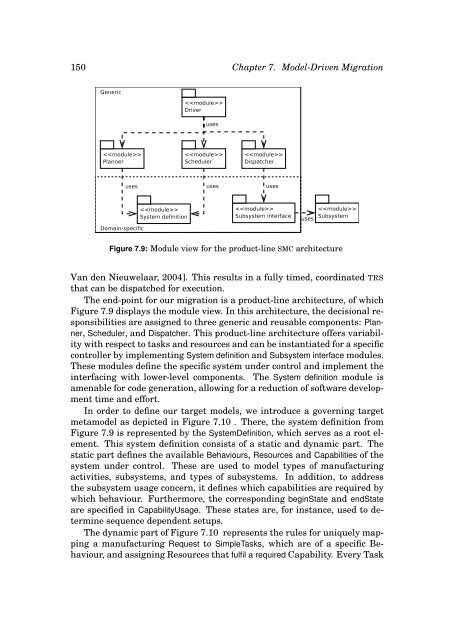Model-Driven Evolution of Software Architectures - Software and ...
Model-Driven Evolution of Software Architectures - Software and ...
Model-Driven Evolution of Software Architectures - Software and ...
You also want an ePaper? Increase the reach of your titles
YUMPU automatically turns print PDFs into web optimized ePapers that Google loves.
150 Chapter7. <strong>Model</strong>-<strong>Driven</strong>Migration<br />
Figure 7.9:Moduleviewfortheproduct-lineSMCarchitecture<br />
V<strong>and</strong>enNieuwelaar,2004].Thisresultsinafullytimed,coordinatedTRS<br />
thatcanbedispatchedforexecution.<br />
Theend-pointforourmigrationisaproduct-linearchitecture,<strong>of</strong>which<br />
Figure7.9displaysthemoduleview.Inthisarchitecture,thedecisionalresponsibilitiesareassignedtothreegeneric<strong>and</strong>reusablecomponents:Planner,<br />
Scheduler,<strong>and</strong> Dispatcher.Thisproduct-linearchitecture<strong>of</strong>fersvariabilitywithrespecttotasks<strong>and</strong>resources<strong>and</strong>canbeinstantiatedforaspecific<br />
controllerbyimplementing System definition<strong>and</strong> Subsystem interfacemodules.<br />
Thesemodulesdefinethespecificsystemundercontrol<strong>and</strong>implementthe<br />
interfacingwithlower-levelcomponents. The System definitionmoduleis<br />
amenableforcodegeneration,allowingforareduction<strong>of</strong>s<strong>of</strong>twaredevelopmenttime<strong>and</strong>effort.<br />
Inordertodefineourtargetmodels,weintroduceagoverningtarget<br />
metamodelasdepictedinFigure7.10. There,thesystemdefinitionfrom<br />
Figure7.9isrepresentedbythe SystemDefinition,whichservesasarootelement.<br />
Thissystemdefinitionconsists<strong>of</strong>astatic<strong>and</strong>dynamicpart. The<br />
staticpartdefinestheavailable Behaviours, Resources<strong>and</strong> Capabilities<strong>of</strong>the<br />
systemundercontrol. Theseareusedtomodeltypes<strong>of</strong>manufacturing<br />
activities,subsystems,<strong>and</strong>types<strong>of</strong>subsystems. Inaddition,toaddress<br />
thesubsystemusageconcern,itdefineswhichcapabilitiesarerequiredby<br />
whichbehaviour. Furthermore,thecorresponding beginState<strong>and</strong> endState<br />
arespecifiedin CapabilityUsage. Thesestatesare,forinstance,usedtodeterminesequencedependentsetups.<br />
Thedynamicpart<strong>of</strong>Figure7.10 representstherulesforuniquelymappingamanufacturing<br />
Requestto SimpleTasks,whichare<strong>of</strong>aspecificBehaviour,<strong>and</strong>assigningResourcesthat<br />
fulfilarequiredCapability.EveryTask

















